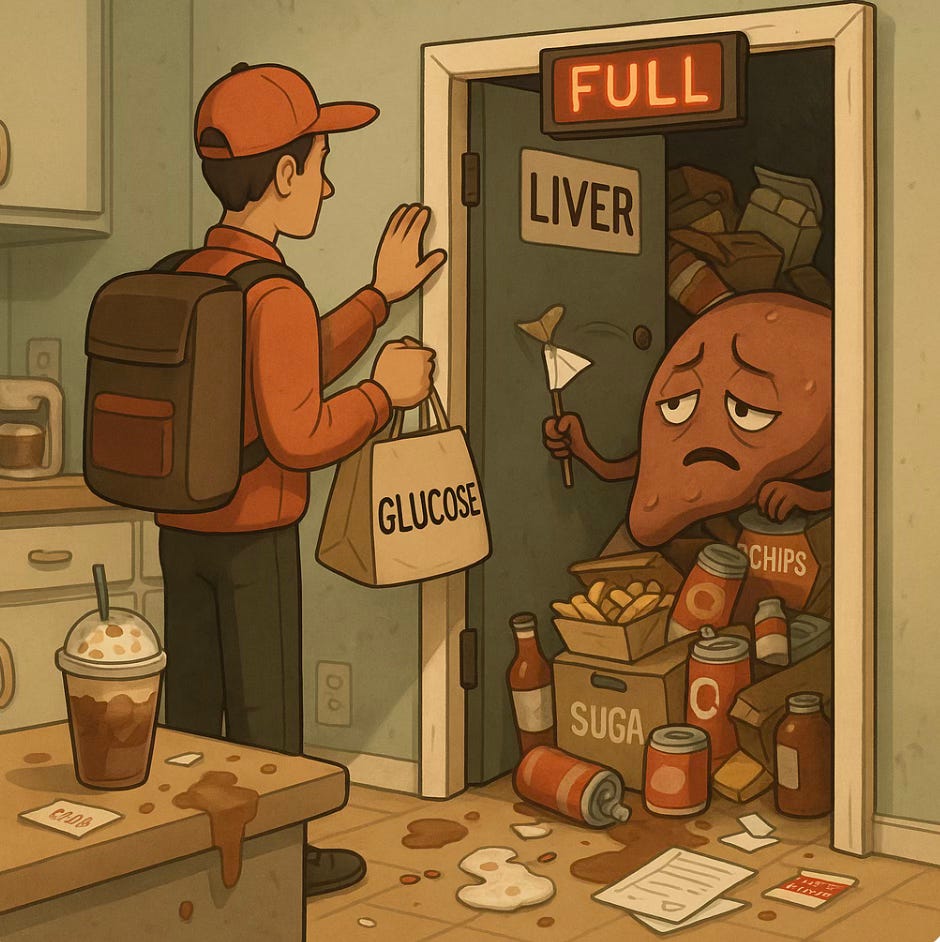Your Liver Called. It Wants a Restraining Order Against Your Fork.
Your liver wasn’t built for frappes, grazing, and midnight DoorDash.
It didn’t start with gluttony or laziness.
It started with a job, one the liver never applied for but keeps trying to do anyway.
See, your liver is a silent workhorse. Not glamorous. Not loud. Just steady. It stores fuel, breaks down toxins, makes cholesterol when needed, and yes, if the rest of the team bails, it makes fat out of sugar.
Not because it wants to.
Because someone has to.
At first, the system worked.
You’d eat. Your pancreas sent out insulin. The muscles opened their doors and welcomed the glucose in. Your fat cells politely took the leftovers. And your liver? It stayed in the background, humming along.
But over time, the rhythm broke.
Meals came more often. Bigger. Louder. Sneakier.
Snacks between meals. Lattes as dessert. Refined carbs paired with saturated fat in a tag-team assault. Movement slowed. Sleep shortened. The cleanup crew went on strike.
The liver didn’t complain.
It stepped up.
Until one day, the warehouse was full.
The Overflow Begins
Glucose couldn’t get into muscle. Fat cells were maxed out. So insulin turned to the liver:
“Can you take this?”
And the liver said yes.
Again. And again. And again.
Through a process called de novo lipogenesis, your liver took excess sugar and turned it into fat. Not to export. Not to store in your thighs. But to stuff into itself.
This is not what it was built for.
This is like turning your dining room into a storage unit.
At first, you barely notice. But the chairs get moved. The floor disappears. You forget where the light switch even is. And eventually, you can’t even walk through the room without tripping over your own stuff.
Now imagine that, biologically.
Fat builds up inside liver cells, squeezing out space, disrupting communication, muffling insulin’s signal.
Insulin knocks.
The liver shrugs.
And then?
It starts releasing glucose even when you haven’t eaten—because the signal system is broken.
That’s hepatic insulin resistance. And it’s quiet. It builds over years. But it changes everything.
Signs of a Full Liver Warehouse
Your lab work whispers it first:
Fasting glucose (blood sugar) starts climbing.
Triglycerides (the fats in your blood) rise.
Liver enzymes (ALT, AST) tick upward.
An ultrasound maybe shows “fatty liver.”
But no one talks about why.
The why is metabolic overwhelm. A liver buried in its own backlog. Still trying. Still working. But no longer listening.
Why the Liver Gets So Loud—and How to Quiet It Again
Not with a detox.
Not with a supplement stack named after a rainforest.
With rhythm. With respect. With a five-step repair plan that’s so unsexy, most people scroll past it.
But not you.
Because you’re still reading.
Here’s how you give your liver space to breathe again:
1. Stop the Constant Deliveries (Meal Frequency Matters)
Every time you eat, insulin shows up. That’s her job. But constant eating = constant knocking = burnout.
Try this:
12–14 hours between dinner and breakfast.
Three meals a day, not six.
No snacks unless you’re doing hard labor.
Let insulin rest. Let the liver catch up.
2. Unpack the Junk (Ditch Ultra-Processed Foods)
The liver doesn’t mind work. But it hates mystery boxes. Highly processed food is biochemical chaos—sugar, fat, chemicals, emulsifiers—all in one.
Stop sending Amazon orders to your biology.
Start sending beans, greens, berries, oats, cruciferous veggies, lentils.
Let the liver see what’s coming.
3. Move the Storage (Muscle Is the Exit Strategy)
When you move, your muscles act like vacuums. They suck up glucose, no insulin required.
No CrossFit required. Just:
Walk after meals.
Do bodyweight squats.
Lift something heavier than your phone.
Movement isn’t optional. It’s liver medicine.
4. Add the Organizers (Fiber = Metabolic Order)
Fiber slows digestion. Lowers glucose spikes. Reduces liver fat. It’s not flashy. It’s effective.
Get 35–50g or more a day from:
Lentils, chickpeas, oats
Vegetables (especially leafy and crunchy ones)
Berries, flax, chia, nuts
Fiber is not about the bathroom. It’s about bandwidth.
5. Clean Up Overnight (Sleep Is the Night Shift Supervisor)
You can’t undo chaos while binging on Netflix at midnight.
Your liver restores order while you sleep, if you let it.
Sleep 7–9 hours. Avoid food 2 hours before bed. Get sunlight in the morning.
Let your body run its software updates.
Here’s What Happens When You Do
Fasting glucose drops.
Triglycerides fall.
Insulin stops shouting.
The liver? It starts responding again.
You’re not reversing disease. You’re restoring design.
You’re reminding your liver that it’s safe. That the emergency is over. That it doesn’t have to hoard fuel anymore.
Because you finally stopped overfeeding it.
Final Word: The Liver Isn’t Lazy—It’s Overloaded
This isn’t a detox.
It’s a quiet revolution.
It’s a choice to stop sending chaos downstream and blaming the organ that caught it.
You don’t need to punish your body into compliance.
You need to declutter your inputs.
Fewer boxes.
More rhythm.
And one healing habit at a time.
Ready to Stop Overfeeding the Chaos?
If this article hit a little too close to home, good. That means your liver’s still listening.
Inside The Habit Healers Mindset’s Inner Circle, we don’t do guilt. We do rhythm. Quiet power. Small, smart shifts that retrain your biology from the inside out, starting with habits your liver will actually thank you for.
Every week, you’ll get private guides delivered straight to your inbox:
Real tools. No fluff. No fads. Just healing, habit by habit.
Join us now and start rewiring the systems that got you here.
Your fork—and your liver—will be in better hands.
Become a member of the Inner Circle today.






This is great. As usual: so clear, so direct, so irrefutable. You bring new light to the morass of bewildering health advice. Thank you.
Great article, great analogies and very understandable!!